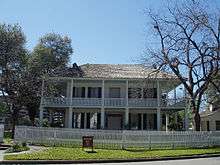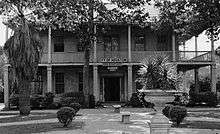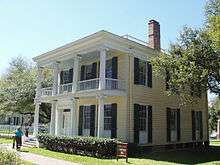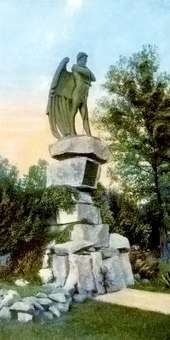Sam Houston Park
Sam Houston Park is an urban park located in downtown Houston, Texas, United States, dedicated to the buildings and culture of Houston's past. The park, which was the first to be established in the city, was developed on land purchased by former Mayor Sam Brashier in 1900.


History

Mayor Brashear appointed Houston’s first park committee to oversee the establishment of a city park in 1899. The 20 acres (81,000 m2) chosen for the park was landscaped into a Victorian-styled village, with footpaths leading past an old mill and across a bridge that traversed a small stream. The park also included a 52-year-old house that had long been used as a school.[1]
The Heritage Society
The Heritage Society was founded by Houstonians Faith Bybee, Harvin Moore and Marie Phelps in 1954, and Sam Houston Park has been its home ever since.[1]
The purpose of the Society is to preserve the history of the community and region through preservation and restoration of historic structures, exhibition of historical artifacts, and presentation of educational programs which focus on Houston and Harris County's diverse past, and its relationship to the present and future.[2]
Also located in Sam Houston Park, at the corner of Bagby and Lamar Streets, is a small museum, the Heritage Society Museum, which is dedicated to preserving Houston's history.

Historic homes



Several historic homes are located in the park. The buildings are representative of many eras, from a pre-Texas revolution cabin to an 1891 church built by German and Swiss immigrants, including the Kellum-Noble House, Houston's oldest brick dwelling, which was built by Nathaniel Kellum in 1847. Guided tours of the restored buildings are available from the Heritage Society.
A Virginian who came to Houston in 1839, Kellum operated a brick kiln, a tannery and saw mill on the property. During the 1850s, Mrs. Zerviah M. Noble conducted one of Houston's first private schools in this house. Kellum-Noble is the only house in the Park on its original site.
During the late 1930s and early 1940s, the Kellum-Noble House served as a public office for the City of Houston's Park Department. It is listed as a Historic American Building by the U.S. Library of Congress.
The Nichols-Rice-Cherry House (which was moved from San Jacinto Street) is also located in Sam Houston Park. It is an example of Greek Revival architecture and was built about 1850 by Ebeneezer B. Nichols from New York. Between 1856 and 1873 it was owned by financier William Marsh Rice, whose estate helped create Rice Institute (now Rice University) in 1912.
Other historic buildings now located in Sam Houston Park include:[1]
- The Old Place - a rustic cabin built of rough-sawn cedar planks about 1823.
- Fourth Ward Cottage - moved from Freedman’s Town to the Park in 2002, it may predate 1858.
- Pillot House - built in 1868, and owned by the same family until 1964, it is believed to be the first house in Houston built with an attached kitchen. The family was related to the Henke and Pillot supermarket chain.

- Yates House - built in Freedman’s Town in 1870 by affluent former slave Jack Yates
- St. John Church - built in 1891 by an Evangelical Lutheran congregation that conducted services in German until well into the twentieth century.
- Staiti House - built in 1905 and featured electrical wiring.
The Old Place is a log cabin probably built by John R. Williams, an Austin colonist, about 1823, and thought to be the oldest remaining structure in Harris County.[3] It was moved from its original location on the west bank of Clear Creek in 1973 and remained at the west edge of the Park, on the shore of the pond, until September 2003, when it was relocated to higher ground on the east side of the Park.[4] Rising waters from Buffalo Bayou had flooded the building numerous times over the years, and during Tropical Storm Allison in June 2001, floodwaters reached the roof.[5]

Gallery: Postcard scenes in Sam Houston Park
(c. means "circa" which means "around".)
%2C_Houston%2C_Texas.jpg) Band concert (c. 1910)
Band concert (c. 1910) Wading pond (c. 1900-1924)
Wading pond (c. 1900-1924).jpg) Children's playground (c. 1909)
Children's playground (c. 1909) House and bell (c. 1900-1924)
House and bell (c. 1900-1924) Lake (c. 1907)
Lake (c. 1907) Lake scene (c. 1911)
Lake scene (c. 1911) Confederacy monument (c. 1912-1924)
Confederacy monument (c. 1912-1924) South Entrance (c. 1912-1924)
South Entrance (c. 1912-1924) Scene (c. 1907)
Scene (c. 1907) Play grounds and band stand (c. 1912-1924)
Play grounds and band stand (c. 1912-1924)
See also
References
- "Sam Houston Park". Houston Parks, City of Houston, www.houstontx.gov. Archived from the original on May 4, 2007. Retrieved 2007-05-14.
- "About Us". Heritage Society in Sam Houston Park, www.heritagesociety.org. Retrieved 2007-05-14.
- "1823 Old Place". The Heritage Society at Sam Houston Park.
- Turner, Allan (2003-10-20). "HIGHER GROUND / Society works to keep historic homes dry". Houston Chronicle. Archived from the original on 2012-10-16. Retrieved 2011-07-28.CS1 maint: BOT: original-url status unknown (link)
- "For Theater District, an artistic nightmare". Houston Chronicle. 2001-06-12.
Further reading
Boesel, Minnette (2014). "Historic Preservation" (PDF). The Houston Review. 3 (2): 4–9, 51.
External links
| Wikimedia Commons has media related to Sam Houston Park. |
